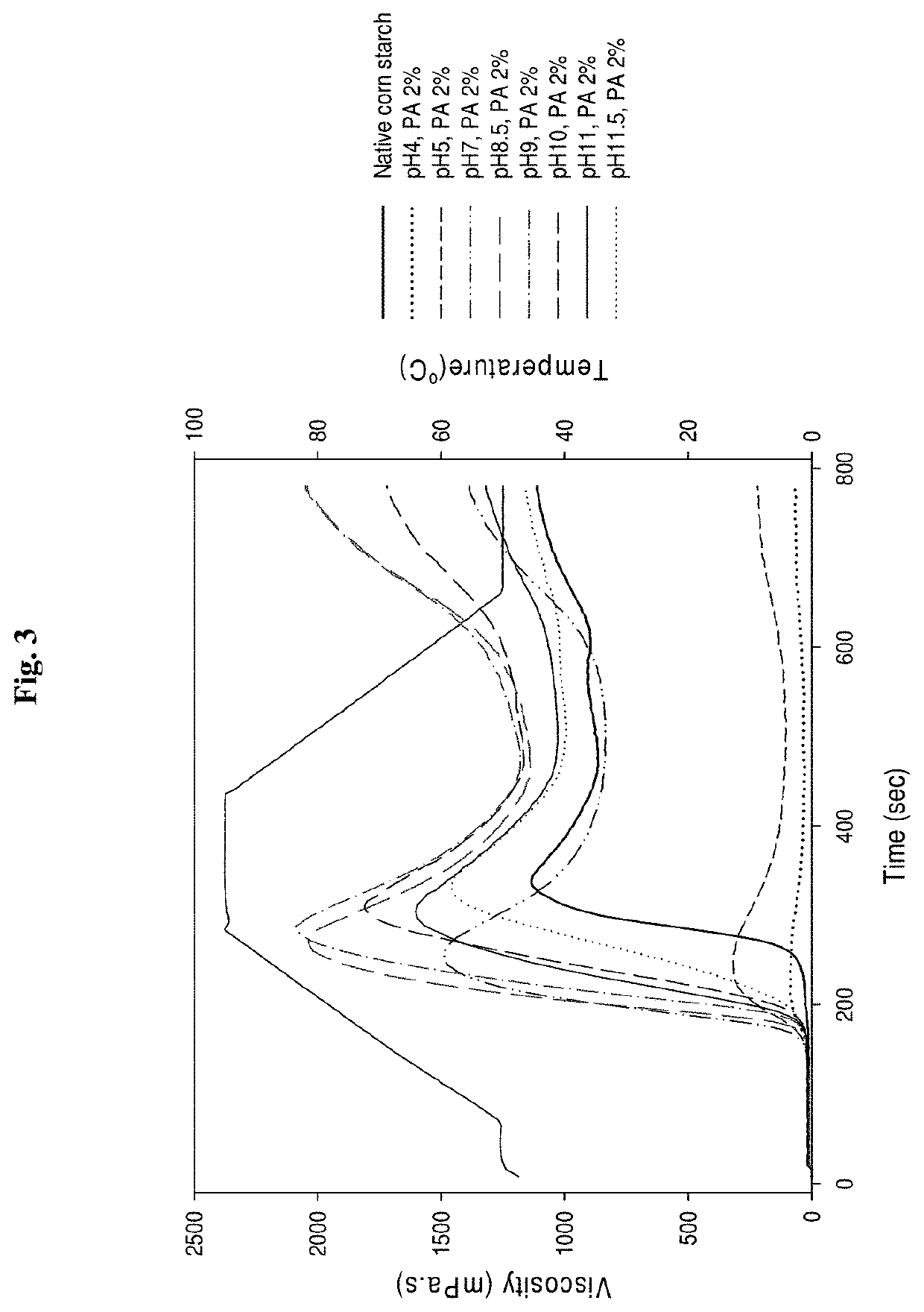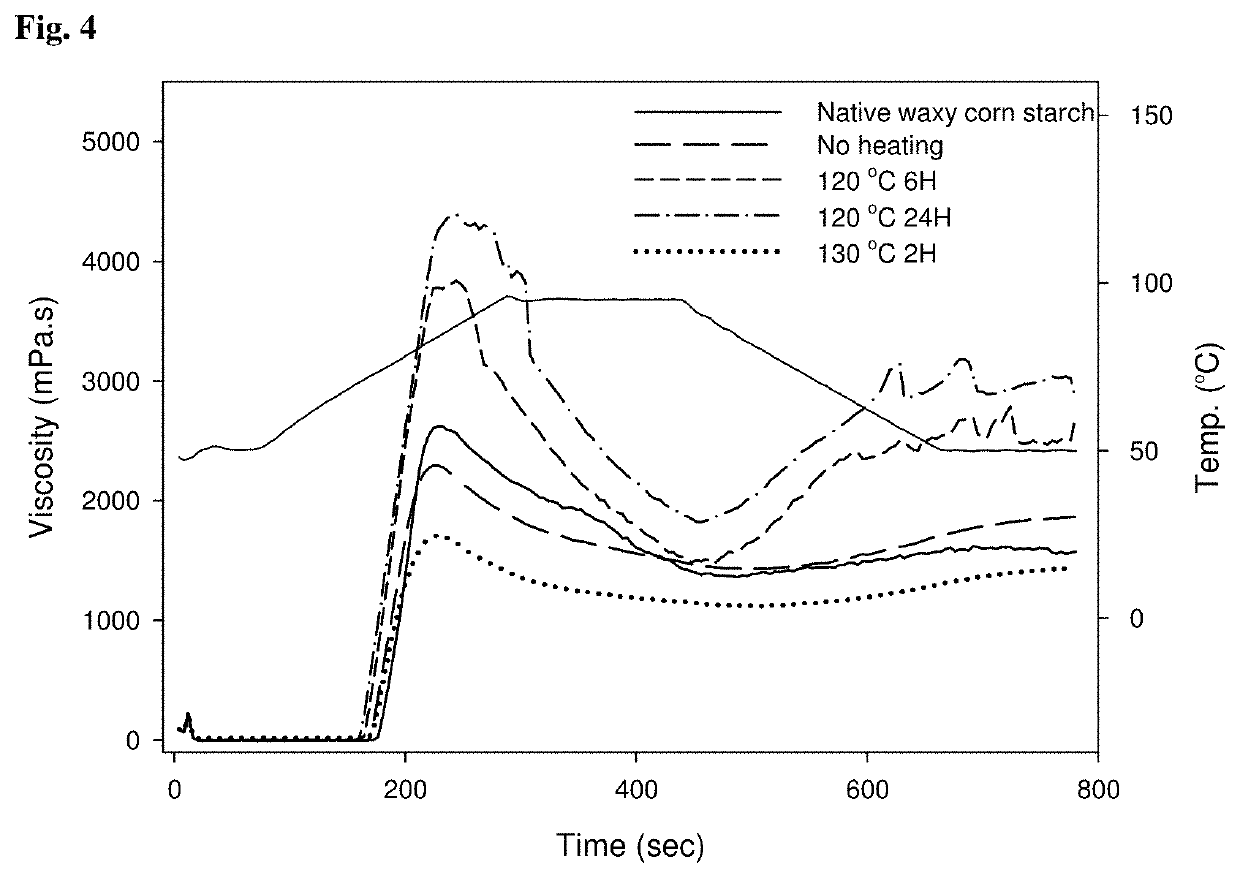Method for preparing starch phosphate using phytate
a technology of starch phosphate and phytate, which is applied in the field of preparing starch phosphate, can solve the problems of poor stability and insufficient utilization of native starches, and achieve the effects of improving the quality and storage stability of various starchy foods, improving physical properties, and high transparency
- Summary
- Abstract
- Description
- Claims
- Application Information
AI Technical Summary
Benefits of technology
Problems solved by technology
Method used
Image
Examples
example 1
on of Starch Phosphates Using Phytate and Measurement of Pasting Properties Depending on Preparation Conditions
[0049]1-1. Measurement of Pasting Properties of Starch Phosphate at Different Dispersion Temperature and Time
[0050]Waxy corn starch dispersion (40 wt %) was prepared with phytate (2%, w / w, starch basis) in a buffer at pH 10. The starch-phytate dispersion was stirred under four different conditions: 1) at ambient temperature for 1 h and 2) at 50° C. for 1 h, 3) at 50° C. for 3 h, and 4) at 50° C. for 5 h. Then, each of the dispersions was dried in a convection oven at 40° C. and powdered. The powder was heated at 120° C. for 6 h, dispersed in water for neutralization, washed three times with water, and dried in a convection oven at 40° C. to prepare a starch phosphate. The starch phosphate was pulverized before use in the following experiments.
[0051]Then, the pasting viscosities of the native starch and the starch phosphates whose concentrations were adjusted to 7.0% (2.1 g ...
example 2
nt of Physicochemical Properties of Starch Phosphates Prepared Using Phytate
[0078]2-1. Phosphorus Contents of Native Starches, Control Starches, and Starch Phosphates Prepared by the Inventive Method
[0079]Each of the starches (0.5 g) was dispersed in 2.5 mL nitric acid and 0.5 mL hydrochloric acid, heated at 90° C. for 60 min, cooled, diluted to a final volume of 50 mL with distilled water. Phosphorus content was measured by inductively coupled plasma-optical emission spectroscopy (ICP-OES). Phosphorus content of native, control, starch phosphate prepared using phytate is shown in Table 2.
TABLE 2P (ppm)Waxy cornNative11.5 ± 0.6 cstarch120° C. 6 HControlND2% Phytate50.1 ± 0.2 b120° C. 24 HControlND2% Phytate92.9 ± 1.0 aWaxy riceNative27.5 ± 0.0 cstarch120° C. 6 HControlND2% Phytate43.1 ± 0.5 b120° C. 24 HControlND2% Phytate79.3 ± 1.7 aND: Not detected
[0080]Phytate is also known as hexaphosphorylated inositol. Native starches naturally contain phosphorus in the form of phytate. Native...
PUM
| Property | Measurement | Unit |
|---|---|---|
| pH | aaaaa | aaaaa |
| temperature | aaaaa | aaaaa |
| pasting temperature | aaaaa | aaaaa |
Abstract
Description
Claims
Application Information
 Login to View More
Login to View More - R&D
- Intellectual Property
- Life Sciences
- Materials
- Tech Scout
- Unparalleled Data Quality
- Higher Quality Content
- 60% Fewer Hallucinations
Browse by: Latest US Patents, China's latest patents, Technical Efficacy Thesaurus, Application Domain, Technology Topic, Popular Technical Reports.
© 2025 PatSnap. All rights reserved.Legal|Privacy policy|Modern Slavery Act Transparency Statement|Sitemap|About US| Contact US: help@patsnap.com



